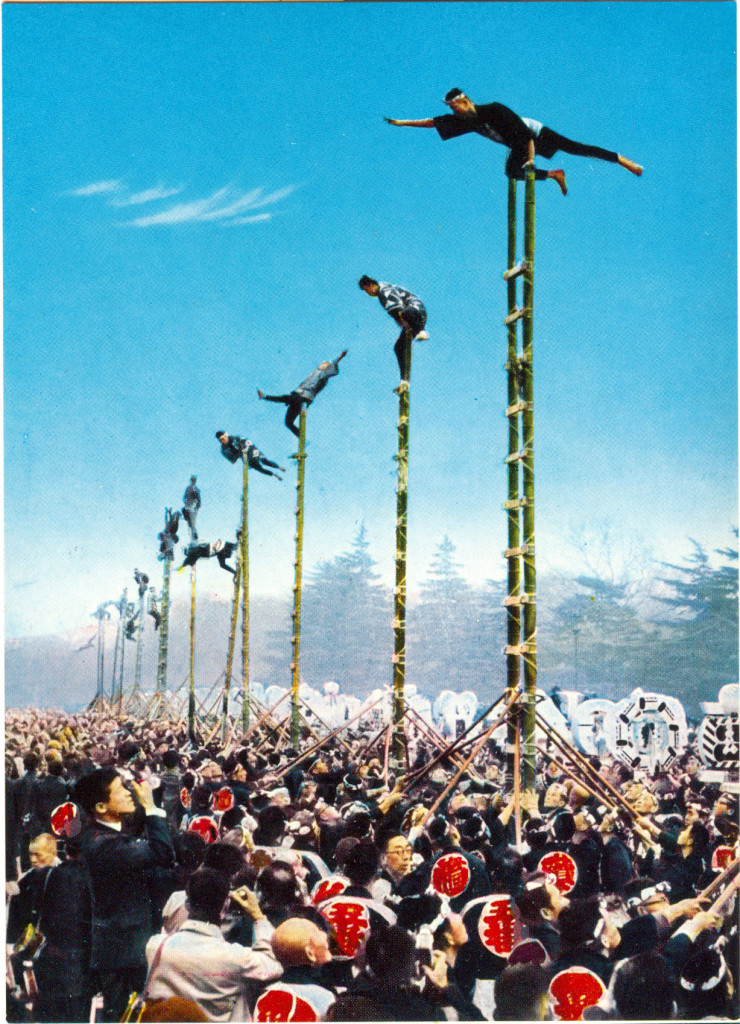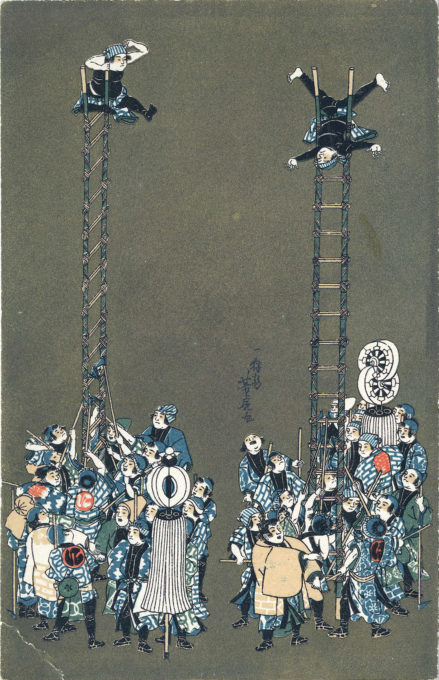“The ‘first event’ [of the New Year] takes on special significance in professions where safety is an issue. The most famous of such celebrations is reserved for firemen.
“Each year fire companies across Japan have a dezome-shiki [first event] which usually includes a parade and demonstrations. Firemen dressed in Edo-period firefighting attire carry traditional firemen standards [matoi] and ride on both antique and modern fire trucks.
“To ensure a safe year and to pay respect to the old firefighting traditions, designated firemen climb tall bamboo ladders and perform thrilling acrobatic feats with the cheering support of thousands of observers.
“In an earlier era of wooden buildings, entire villages depended on the skills of firemen, and these performances pay tribute to the past while hoping to guarantee continued safety and success in the coming year.”
– Bamboo in Japan, by Nancy Moore Bess & Bibi Wein, 2001

Dezome-shiki, New Year’s Day, c. 1960. Back-caption: “It is a parade that all members of the fire brigades exercise for group action on the New Year’s Day. In Tokyo, all members of fire brigades meet on 6th January in the front yard of the Imperial Palace, and they perform several exercises and show us the ladder top tricks by the men called TOBI in Edo era as a special observance of new year.”
“Dezome-shiki [debut ceremony, i.e. the first event of the year] is an annual ceremony featuring firefighting, rescue, and first-aid demonstrations by the Tokyo Fire Department. There are also performances of traditional kiyari songs and ladder-top stunts by the Edo Firemanship Preservation Association.
“Organized by the TFD, this is an event held to pray for a safe year. The main attraction is the ladder stunts. Men dressed as firemen of the Edo Period (1605-1868) perform circus-like acrobatic stunts on top of bamboo which tower over the heads of the men supporting them. These demonstrations have been held since then to warn people of the dangers of fire.
“The ladder was an indispensable fire-fighting tool in the Edo Period. This was because the main method back then was to tear down the surrounding buildings to prevent fire from spreading, so there was a need to climb up onto roofs. As agile movement was required, it was mostly nimble scaffolding workers who served as firemen in each town. These workers set up scaffolding when constructing buildings. As they needed to climb up higher when putting up the scaffolding, they had extraordinary strength and stamina.
“Great fires struck Edo several times, each time burning down large sections of the city. Following the very big fire known as Meireki no Taika, in 1657, the Jobikeshi fire brigade was formed to protect strategic sites such as Edo Castle. Fire corps were stationed full-time at four strategic locations in Edo.
“The New Year’s Parade of Firemen first started with firemen praying in front of the shrine of Ueno Toshogu for a safe and sound year ahead, free of fires for Edo.”
– Wikipedia


